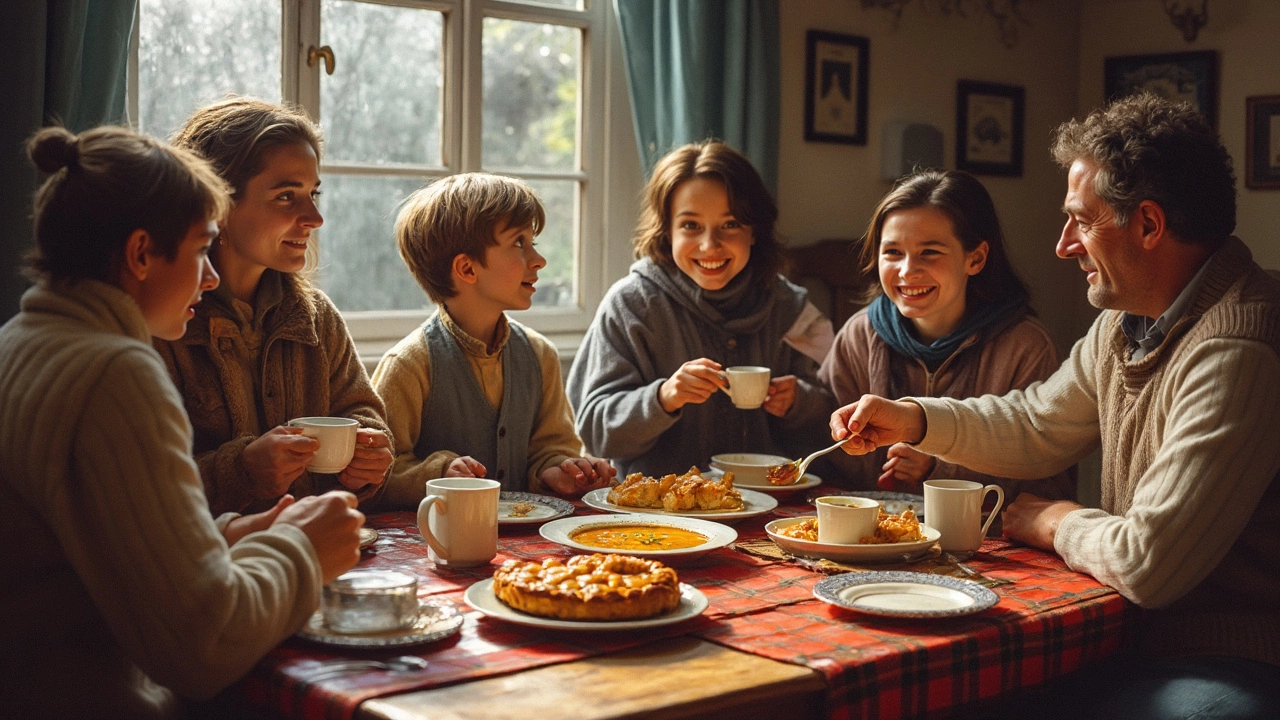
Ever notice how a bowl of chicken soup or grandma’s lasagna just hits differently, especially on a rough day? That’s the magic of traditional comfort food—meals that are simple, familiar, and fill you up in more ways than one. Everyone has a go-to dish that brings back cozy memories or reminds them of home. But what actually qualifies as comfort food?
Comfort food usually means something homemade, often from a recipe that’s been passed down or tweaked over the years. These dishes aren’t fancy, but they’re heavy on flavor and memories. Most people picture classic recipes like mashed potatoes, mac and cheese, or apple pie. But comfort food changes depending on where you grew up and what your family cooked when you needed cheering up.
If you’re looking for practical ways to dig into comfort food, start with the basics: think about what you ate when you needed a pick-me-up as a kid. Was it a grilled cheese sandwich? Maybe a big pot of beef stew? Jot down those dishes. They’re often easier to make than you’d expect—no need for complicated ingredients or fancy equipment.
- What Counts as Traditional Comfort Food?
- Why We Crave Familiar Dishes
- Comfort Foods from Around the World
- Tips for Cooking Your Favorites at Home
What Counts as Traditional Comfort Food?
If you ask five people what traditional comfort food means, you’ll get five different answers. At its core, though, it’s food that makes you feel safe and cared for—usually dishes that families repeat over generations. In places like the US, traditional comfort food brings to mind meatloaf, mac and cheese, or chicken and dumplings. In the UK, people think shepherd’s pie or a steaming plate of bangers and mash. In Japan, folks look to ramen or curry rice. Each culture has its own favorites, but these dishes all have a few things in common.
First, comfort food is usually tied to home and family. It’s the kind of stuff your mom or dad could whip up without a recipe, and it’s not made for special occasions. Instead, these are weeknight dinners or Sunday lunches—hearty, filling, and often carb-heavy. Second, these dishes don’t care about the latest food trends. You probably won’t see kale chips or quinoa bowls here. Comfort means sticking with what works and what’s been proven to satisfy.
There are three big factors that usually define comfort food:
- Familiarity: You’ve eaten these dishes your whole life, often when you needed cheering up.
- Simplicity: The ingredients list rarely surprises anyone—potatoes, cheese, bread, chicken—easy stuff.
- Emotional link: A bowl of chili or a hot biscuit can tap right into childhood memories or make you forget a tough day.
Some studies have actually looked into why certain foods become comfort food. Researchers from the University of Buffalo in 2015 found that comfort food is almost always tied to nostalgia—mom’s casserole or grandpa’s pancakes, for example. So when figuring out what counts as traditional comfort food for you, start with what brings back those memories or what you reach for after a long, hard week.
Why We Crave Familiar Dishes
Ever wonder why you reach for mashed potatoes or that special casserole when life gets messy? It’s not just about taste. Scientists say comfort food actually taps into the emotional “reward” part of your brain. When you eat something tied to good memories, your brain releases feel-good chemicals like dopamine, which lifts your mood. So, that bowl of mac and cheese does more than fill your stomach—it really does make you feel better.
It’s not just the science, either. The foods we consider traditional comfort food are usually linked to childhood or home. Maybe it’s your mom’s stew or your dad’s chili. Eating these dishes brings back a sense of security, like a small break from whatever grown-up problems you’re dealing with at the time. In a 2015 study from Cornell University, researchers found people crave comfort foods most when they're feeling lonely—or when they just need a quick mood boost. There’s some truth to calling that plate of spaghetti a “hug in a bowl.”
Our cravings also line up with our culture and what we grew up with. In the U.S., grilled cheese and tomato soup often pop up as favorites. In Japan, it might be a bowl of ramen shared with family. The “familiar” part is very personal, but the reason behind the craving is the same everywhere—it’s about feeling grounded and cared for.
If you want to use comfort food to really turn your mood around, try cooking it yourself. The process is half the fun and, according to recent studies, actually helps with stress reduction. There’s a reason so many people headed to their kitchens during tough times—the act of making something familiar is just as comforting as eating it.

Comfort Foods from Around the World
Everyone thinks their family makes the best comfort food, but almost every country has its own classic that people rely on for a mood boost. It’s not all mac and cheese and mashed potatoes—though those are hard to beat. Let’s look at some real favorites from different corners of the globe.
- United States: Think chicken and dumplings, meatloaf, or a big plate of cheesy lasagna. Fried chicken and macaroni and cheese are at the top for most Americans.
- United Kingdom: Shepherd’s pie—mashed potatoes piled high on minced meat and veggies—is pretty much the king here. And don’t forget proper fish and chips, especially on a chilly night.
- Italy: Risotto and creamy polenta are top picks. For many Italians, nothing soothes like a warm bowl of pasta, especially spaghetti carbonara or a slow-cooked ragu.
- Japan: People turn to tonkatsu (breaded pork cutlet), hearty bowls of ramen, and Japanese curry rice for comfort. Rice dishes rule here.
- India: Dal with rice or chapati, chana masala, and spicy biryani are all simple but deeply satisfying. Hot chai is almost a requirement on tough days.
- Mexico: Tamales, enchiladas, and pozole—a hominy and pork soup—bring families together when comfort is needed most.
Want to see how these favorites stack up worldwide? Here’s a quick comparison:
| Country | Top Comfort Foods | Common Ingredients |
|---|---|---|
| United States | Meatloaf, Mac & Cheese, Fried Chicken | Beef, cheese, chicken, potatoes |
| Italy | Pasta Ragu, Risotto, Polenta | Pasta, rice, tomatoes, cheese |
| Japan | Ramen, Tonkatsu, Curry Rice | Noodles, pork, rice, curry |
| India | Dal, Biryani, Chana Masala | Lentils, rice, spices |
| Mexico | Tamales, Enchiladas, Pozole | Corn, pork, chilies |
What really drives these dishes isn’t just taste. It’s nostalgia and the ritual of preparing them. Whether you’re digging into a steaming bowl of ramen or pulling apart homemade tamales at a Sunday get-together, traditional comfort food crosses language and borders. Trying a comfort dish from another country can be a fun way to connect with someone else’s culture—and you might find a new favorite to add to your own family’s table.
Tips for Cooking Your Favorites at Home
When it comes to nailing your comfort food recipes at home, you don’t need a culinary degree. Most classic dishes are rooted in everyday cooking and made with what’s on hand. Here are some tried-and-true tips that take your favorite meals from so-so to next-level:
- Use familiar ingredients: Traditional comfort food relies on pantry basics—think flour, eggs, potatoes, cheese, pasta, and chicken. Skip exotic add-ons unless you truly love them.
- Don’t mess with what works: There’s a reason grandma’s mac and cheese is everyone’s top pick. Stick to core flavors and textures that made you love the dish in the first place. For instance, American-style mac and cheese is usually elbow pasta, cheddar cheese, and milk, baked with a simple breadcrumb top.
- Low and slow for flavor: A lot of comfort foods—like stews, soups, or pulled pork—taste better when cooked low and slow. This helps blend flavors and tenderize meats. Try letting your meatloaf or beef stew cook a bit longer than the recipe says for a more intense taste.
- Get the textures right: Creamy, crispy, chewy—whatever your favorite dish is, texture is a big part of it. Toast your bread before making grilled cheese. Mash your potatoes until they’re lump-free. Small tweaks make a huge impact.
For anyone who wants to recreate the feeling of digging into traditional comfort food, fuss-free techniques matter more than fancy skills. Most classic recipes take less than 60 minutes from start to finish. Here’s a quick breakdown of typical prep and cook times for a few favorites:
| Dish | Prep Time | Cook Time | Total Time |
|---|---|---|---|
| Mac and Cheese | 10 minutes | 30 minutes | 40 minutes |
| Chicken Soup | 15 minutes | 45 minutes | 1 hour |
| Meatloaf | 15 minutes | 50 minutes | 1 hour 5 minutes |
| Apple Pie | 20 minutes | 50 minutes | 1 hour 10 minutes |
Some folks tweak their recipes to match their diet—maybe swapping cream for oat milk or making gluten-free casseroles. That’s cool, as long as the main flavors land. If you’re cutting back on salt or sugar, boost herbs or spices to keep things tasty.
Finally, don’t worry if things aren’t picture-perfect. Comfort food is about how it makes you feel, not how it looks on Instagram. And if anyone ever asks for seconds, you’re doing something right!





